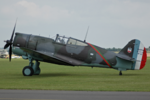yulzari
Tech Sergeant
I too think that the RAF had an opportunity to get large numbers of tactical transports with the Harrow or Bombay. More truly a tactical transport than the Dakota so in a better position to support an airborne operation with air landing support. Very useful in Burma too.

